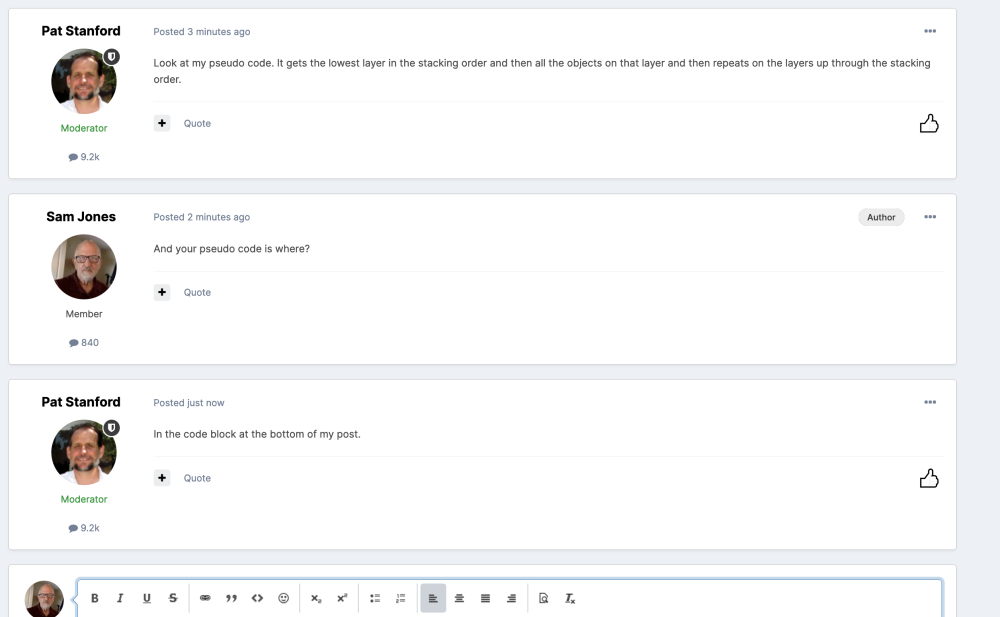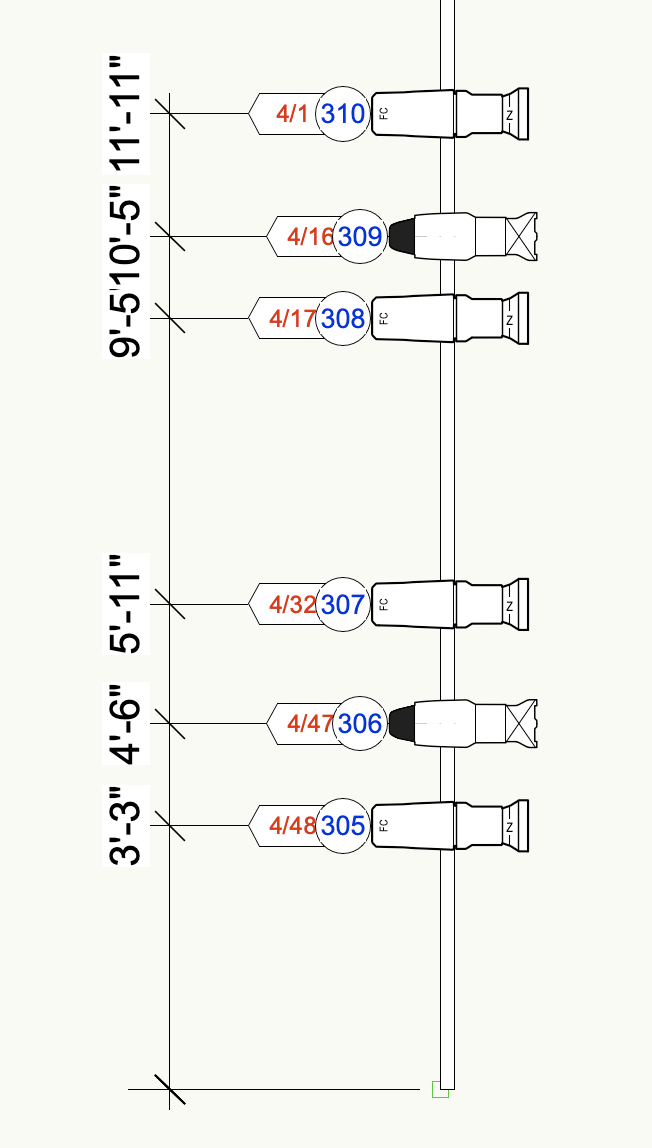-
Posts
1,191 -
Joined
-
Last visited
Content Type
Profiles
Forums
Events
Articles
Marionette
Store
Everything posted by Sam Jones
-

Retrieving the stacking order of objects and layers
Sam Jones replied to Sam Jones's topic in Vectorscript
How do I know what the stacking order is? If I don't need to know what it is, how do I work up through it? I need to make a list of selected symbols, in order to place the dopplegangers. I can then sort the list on any criteria I know about or collect. Theoretically, that would first be by layer order, and then by stacking order. Getting the stacking order is the trick. My preliminary investigations indicate that the handles to the objects do not provide a reliable stacking order, but I am refining my test file and the code to test indications of stacking order. -

Retrieving the stacking order of objects and layers
Sam Jones replied to Sam Jones's topic in Vectorscript
The new doppelganger objects are drawn all on one other layer, different from the selected objects and at a different scale. -

Retrieving the stacking order of objects and layers
Sam Jones replied to Sam Jones's topic in Vectorscript
I want to collect the handles of all the selected editable objects and then place different symbols based on what the selected objects are. I don't want to replace the original selected objects. I just want to place other different symbols (dopplegangers) down in the same stacking order as the stacking order of the original selected symbols. That way the dopplegangers obscure (or not) each other in exactly the same way as the original objects obscure (or not) each other. -

Retrieving the stacking order of objects and layers
Sam Jones replied to Sam Jones's topic in Vectorscript
Pat, I don't think this works with stacking reordered by the user, but i need to make a test file and isolate the issue. @klinzeyHow do I convert a handle to a string. -

Retrieving the stacking order of objects and layers
Sam Jones replied to Sam Jones's topic in Vectorscript
-

Retrieving the stacking order of objects and layers
Sam Jones replied to Sam Jones's topic in Vectorscript
And your pseudo code is where? -

Retrieving the stacking order of objects and layers
Sam Jones replied to Sam Jones's topic in Vectorscript
If I get the layer of an object, how do I know if the layer it is on stacks above or below a layer another object is on? -
Is there a way to retrieve the stacking order (may be relative) of objects in a layer, and is there a way to retrieve the stacking order (number?) of a layer? I want to create some objects based on the visual stacking order of other selected objects. "FSActLayer" and "FSObject" will retrieve object handles in their creation order, and that would yield their stacking order, except when the stacking order is changed by the user. Additionally, I would need to know the relative stacking order of the layers the selected objects are in, because that would change their visible stacking order in the drawing from their creation order. Too much to ask??
-

Hoist Tool - Referenced Origin not Accessible
Sam Jones replied to stayathomedad's question in Wishlist - Feature and Content Requests
Pat is pointing at the correct parameter, but that is a list of alternate names. If you are needing to reference the hoist origin in a formula or are just typing in field names into the database header you will need to use the universal name "OriginName". Typically the formula at the top of the column of hoist origin names is ='BrxHoist'.'OriginName'. You will need to use 'BrxHoist'.'OriginName' in any worksheet formulas that reference that parameter. -
BTW, It is tempting to use the record "Truss Record" as a criteria in order to pick up symbols. However, you cannot use "Truss Record" as a criteria in a drawing that has "TrussItem" objects (items inserted with the Truss Insertion tool). "Truss Item objects have 2 versions of the "Truss Record" attached to them; doubling the number of actual truss pieces.
-
Change the database criteria in Mark's worksheet to =DATABASE(INVIEWPORT & INOBJECT & INSYMBOL & (PON='TrussItem')). This will allow you to count TrussItems in Hanging Positions as well. Additionally, the above criteria will only count truss pieces inserted with the Truss insertion tool. Truss symbols placed in the document as symbols will not be counted with this criteria specification. HTH.
-

Help from the Guild - See Classes/Layers in a different file?
Sam Jones replied to Pat Stanford's topic in Vectorscript
Oops, or calling up the layer dialog manually would also work. -

Help from the Guild - See Classes/Layers in a different file?
Sam Jones replied to Pat Stanford's topic in Vectorscript
So it would seem that that would mean using the text file approach is the only way to copy scale, elevation, transparency, etc into another file. -

Help from the Guild - See Classes/Layers in a different file?
Sam Jones replied to Pat Stanford's topic in Vectorscript
It would be interesting to get a list of object types that can be touched with the BuildResourceList() procedure. It would be very strange if the object type "21" (polyline) was able to be imported. Would that import every polyline in the document? What would the index number even mean? So... Maybe all the "...definition" objects can be touched, but that would leave out "Layer", object type "31". What about Viewports, object type "122" Is there a list or can a list be made of all the objects the BuildResourceList() procedure can see and then be imported by the ImportResourceToCurrentFile() procedure? -

Help from the Guild - See Classes/Layers in a different file?
Sam Jones replied to Pat Stanford's topic in Vectorscript
I can confirm my ignorance. -

Help from the Guild - See Classes/Layers in a different file?
Sam Jones replied to Pat Stanford's topic in Vectorscript
For you, the worksheet seems like a good solution, but the layer and class dialogs do what I need. The esoteric workflows I mentioned revolve around sharing the created text files in a work group situation. Not a lot different from just sharing .vwx files and using the layer and class dialogs, just a little less clicking and a little less file size intensive. And some of my users are just familiar with them. Familiarity, trumps a lot of "workflow stuff". -

Better Projector Tool Roundup
Sam Jones replied to trashcan's question in Wishlist - Feature and Content Requests
Josh, I hope you highlight BeamViz and ProjectionViz at your NY Spotlight User Group presentation. Awesome tools, Awesome 3rd party engineering. They work the way I need them to work. Although I really appreciate the accomplishment that is ProjectionViz, I don't have a lot of use for its power. BeamViz does everything I need to visualize the fixtures in the plot.- 50 replies
-
- 4
-

-
- projection design
- spotlight numbering
-
(and 1 more)
Tagged with:
-

Help from the Guild - See Classes/Layers in a different file?
Sam Jones replied to Pat Stanford's topic in Vectorscript
I never noticed the "choose..." button in those dialogs. That's handier. There are some layer and class sharing workflows that will prefer working with the text files, but they are pretty esoteric. What is the workflow you envisage that would want a script to query another file not using the layer and class dialogs? -

Help from the Guild - See Classes/Layers in a different file?
Sam Jones replied to Pat Stanford's topic in Vectorscript
Nope. I had to make commands that would export file and class names and their attributes to a text file, and commands that would read those text files creating the layers and classes in the active file from which the import commands were run. The scheme works well, but it would be nifty to bypass the export and just read layer and class info from another file. I think you can only read resources from another file, and classes and layers are not resources. If one of the others knows something that I don't that would be great. -
Not a problem Pat. With your command, the user has to select the lights, dimension the lights (with whatever mouse clicks are required, and then run your command. With my command, you select the lights, click where you want to start measuring from, and where you want the text offset. This varies slightly, depending on which dimension command you use.
-
BTW, you can download the tools and use them. They have a 2 month fully functional trial period. It should be enough to get you through a show.
-
-
HCenter() will also give you coordinates of an object if you want the geographic center without doing the arithmetic on the GetBBox coordinates.
-
If I only want to change things that should be changed, 1. Everything I see selected in show/snap/modify layer option OR 2. Only things on the selected layer in all other layer options, since I cannot see what is selected, I do the following LayerOptions := GetLayerOptions; ActiveLyr := ActLayer; ActiveLyrName := GetLName(ActiveLyr); IF LayerOptions = 5 THEN {Show/Snap/Modify Others} ForEachObject(ProcedureToMakeChange, (((VSEL=TRUE) & (main criteria)))) ELSE ForEachObject(ProcedureToMakeChange, (((VSEL=TRUE) & (L=ActiveLyrName) & (main criteria)));







